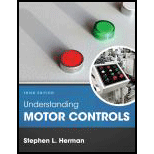Solutions for Understanding Motor Controls
Problem 1RQ:
A manual motor starter controls a single phase 120 volt motor. The motor is not running, and...Problem 4RQ:
A push button manual starter has tripped on overload. Explain how to reset the starter so themotor...Problem 6RQ:
Explain the difference between manual motor starters that provide low voltage release and those that...Browse All Chapters of This Textbook
Chapter 1 - General Principles Of Motor ControlChapter 2 - Symbols And Schematic DiagramsChapter 3 - Manual StartersChapter 4 - Overload RelaysChapter 5 - Relays, Contactors, And Motor StartersChapter 6 - The Control TransformerChapter 7 - Start-stop Push Button ControlChapter 8 - Multiple Push Button StationsChapter 9 - Forward-reverse ControlChapter 10 - Jogging And Inching
Chapter 11 - Timing RelaysChapter 12 - Sequence ControlChapter 13 - Pressure Switches And SensorsChapter 14 - Float Switches And Liquid Level SensorsChapter 15 - Flow SwitchesChapter 16 - Limit SwitchesChapter 17 - Temperature Sensing DevicesChapter 18 - Hall Effect SensorsChapter 19 - Proximity DetectorsChapter 20 - PhotodetectorsChapter 21 - Reading Large Schematic DiagramsChapter 22 - Installing Control SystemsChapter 23 - Across-the-line StartingChapter 24 - Resistor And Reactor Starting For Ac MotorsChapter 25 - Autotransformer StartingChapter 26 - Wye-delta StartingChapter 27 - Part Winding StartersChapter 28 - Direct Current MotorsChapter 29 - Single-phase MotorsChapter 30 - BrakingChapter 31 - Wound Rotor MotorsChapter 32 - Synchronous MotorsChapter 33 - Consequent Pole MotorsChapter 34 - Variable Voltage And Magnetic ClutchesChapter 35 - Solid-state Dc Motor ControlsChapter 36 - Variable Frequency ControlChapter 37 - Motor InstallationChapter 38 - Programmable Logic ControllersChapter 39 - Programming A Programmable Logic ControllerChapter 40 - Analog Sensing For Programmable Logic ControllerChapter 41 - Developing Control CircuitsChapter 42 - Troubleshooting
Sample Solutions for this Textbook
We offer sample solutions for Understanding Motor Controls homework problems. See examples below:
Chapter 1, Problem 1RQThe symbol shown in Figure 1 is used in a schematic of control circuits to designate normally open...Chapter 3, Problem 1RQOverload relays are used to protect the motor from overloading by sensing the current flow in the...The difference between the clapper type and bridge type contacts are as follows: Clapper type...Chapter 6, Problem 1RQChapter 7, Problem 1RQThere are circumstances where it is desirable to have more than one start/stop push button when...By changing any of the two motor leads, the direction of rotation of any three-phase motor can be...
Chapter 10, Problem 1RQChapter 11, Problem 1RQChapter 12, Problem 1RQChapter 13, Problem 1RQChapter 14, Problem 1RQChapter 15, Problem 1RQChapter 16, Problem 1RQChapter 17, Problem 1RQChapter 18, Problem 1RQChapter 19, Problem 1RQChapter 20, Problem 1RQChapter 21, Problem 1RQThe point-to-point connection method is a method used for the installation of components in a...Chapter 23, Problem 1RQThe two electrical components connected in series with the motor to limit the starting current are:...The autotransformer is used to reduce the amount of inrush current by reducing the voltage applied...Chapter 26, Problem 1RQIf a dual voltage 240/480V motor is used for a part winding starting, then the low voltage setting...A direct current motor is an electrical device that produces mechanical work for the electrical...Split phase motor works by splitting a single phase into two phases to mimic a two-phase power...Chapter 30, Problem 1RQOne of the three major types of the three-phase motor is the wound rotor motor. The wound rotor...The synchronous motors can produce a leading power factor and can operate at the synchronous speed....Synchronous speed: The speed at which the magnetic field rotates in a motor is called the...Synchronous speed: The speed at which the magnetic field rotates in a motor is called the...The alternating current (AC) voltage is converted to direct current (DC) voltage in DC motors using...Given information: Number of poles per phase, P=6. Frequency of the supply, f=20 Hz. Calculation:...Given information: Horsepower is 20 HP. Armature voltage rating is 500 V Solution: Refer Table...Chapter 38, Problem 1RQChapter 39, Problem 1RQChapter 40, Problem 1RQChapter 41, Problem 1RQChapter 42, Problem 1RQ
More Editions of This Book
Corresponding editions of this textbook are also available below:
Understanding Motor Controls
1st Edition
ISBN: 9781401890162
Student Cd For Herman’s Understanding Motor Controls
1st Edition
ISBN: 9781111537074
UNDERSTANDING MOTOR CONTROLS>CUSTOM<
3rd Edition
ISBN: 9781337950855
EBK UNDERSTANDING MOTOR CONTROLS
3rd Edition
ISBN: 8220101435002
Mindtap Electrical, 2 Terms (12 Months) Printed Access Card For Herman's Understanding Motor Controls
3rd Edition
ISBN: 9781337792561
Bundle: Understanding Motor Controls, 4th + Mindtap Electrical, 2 Terms (12 Months) Printed Access Card
4th Edition
ISBN: 9780357097755
MindTap for Herman's Understanding Motor Controls, 4th Edition [Instant Access], 2 terms
4th Edition
ISBN: 9781337798754
Understanding Motor Controls
4th Edition
ISBN: 9781337798686
UNDERSTANDING MOTOR CONTROLS
4th Edition
ISBN: 2818440032356
EBK MINDTAP FOR HERMAN'S UNDERSTANDING
4th Edition
ISBN: 9781337798761
Understanding Motor Controls
2nd Edition
ISBN: 9781111135416
EBK UNDERSTANDING MOTOR CONTROLS
2nd Edition
ISBN: 8220100447525
EBK UNDERSTANDING MOTOR CONTROLS
2nd Edition
ISBN: 9781133713913
Related Mechanical Engineering Textbooks with Solutions
Still sussing out bartleby
Check out a sample textbook solution.
